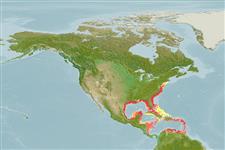>
Eupercaria/misc (Various families in series Eupercaria) >
Haemulidae (Grunts) > Haemulinae
Etymology: Orthopristis: Greek, ortho = straight + Greek, pristis = saw (Ref. 45335).
More on author: Linnaeus.
Environment: milieu / climate zone / depth range / distribution range
Ecología
marino; salobre demersal; oceanodromo (Ref. 51243); rango de profundidad 10 - ? m (Ref. 25). Temperate; 41°N - 10°N, 99°W - 60°W
Western Atlantic: New York, USA and Bermuda to Mexico.
Length at first maturity / Tamaño / Peso / Age
Maturity: Lm 20.0 range ? - ? cm
Max length : 46.0 cm SL macho / no sexado; (Ref. 25); common length : 30.0 cm TL macho / no sexado; (Ref. 3798); peso máximo publicado: 900.00 g (Ref. 25); edad máxima reportada: 4 años (Ref. 25)
Espinas dorsales (total): 12 - 13; Radios blandos dorsales (total): 15-16; Espinas anales 3; Radios blandos anales: 12 - 13. Back elevated; snout long and tapering. Mouth a little oblique; maxillary reaching vertical from first nostril. Scales in oblique rows above lateral line and horizontal rows below lateral line, extending on base of caudal, pelvic and pectoral fins; also forming a low sheath on base of anal and dorsal fins.
Inhabits coastal waters, over sand and mud bottoms. Forms schools. Mainly nocturnal and non-burrowing. Feeds on crustaceans and smaller fishes. Undergoes seasonal migration as well as local nocturnal-diurnal foraging migrations (Ref. 25).
Spawning may occur in open water just prior to inshore migration or in quiet inshore waters, such as harbors, estuaries, and inshore banks, but may begin on outer shores first. Pigfish spawn at dusk exclusively. In general, larger fish spawn first, with smaller ones spawning latest in the season.
Darcy, G.H., 1983. Synopsis of biological data on the pigfish, Orthopristis chrysoptera (Pisces: Haemulidae). FAO Fish. Synop. (134); NOAA Tech. Rep. NMFS Circ. (449). (Ref. 25)
IUCN Red List Status (Ref. 130435)
Threat to humans
Harmless
Human uses
Pesquerías: escaso valor comercial; Acuario: Acuarios públicos; carnada: usually
Herramientas
Special reports
Download XML
Fuentes de Internet
Estimates based on models
Preferred temperature (Ref.
123201): 15.5 - 27.8, mean 24.4 °C (based on 232 cells).
Phylogenetic diversity index (Ref.
82804): PD
50 = 0.5078 [Uniqueness, from 0.5 = low to 2.0 = high].
Bayesian length-weight: a=0.01778 (0.01127 - 0.02805), b=3.01 (2.87 - 3.15), in cm total length, based on LWR estimates for this species & (Sub)family-body (Ref.
93245).
Nivel trófico (Ref.
69278): 3.4 ±0.0 se; based on diet studies.
Resiliencia (Ref.
120179): Medio, población duplicada en un tiempo mínimo de 1.4-4.4 años (tmax=4).
Fishing Vulnerability (Ref.
59153): Moderate vulnerability (42 of 100).
Climate Vulnerability (Ref.
125649): High to very high vulnerability (75 of 100).
Nutrients (Ref.
124155): Calcium = 32.1 [10.0, 72.4] mg/100g; Iron = 0.332 [0.169, 0.681] mg/100g; Protein = 18.5 [16.6, 20.5] %; Omega3 = 0.446 [0.203, 0.892] g/100g; Selenium = 11.1 [5.4, 23.4] μg/100g; VitaminA = 9.22 [2.89, 28.64] μg/100g; Zinc = 0.579 [0.380, 0.871] mg/100g (wet weight);
